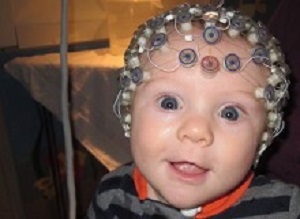 A study shows that EEGs accurately predict or rule out autism spectrum disorder (ASD) in infants, even in some as young as 3 months.
A study shows that EEGs accurately predict or rule out autism spectrum disorder (ASD) in infants, even in some as young as 3 months.
"EEGs are low-cost, non-invasive and relatively easy to incorporate into well-baby check-ups," says Dr Charles Nelson, director of the Laboratories of Cognitive Neuroscience at Boston Children's Hospital and co-author of the study. "Their reliability in predicting whether a child will develop autism raises the possibility of intervening very early, well before clear behavioural symptoms emerge. This could lead to better outcomes and perhaps even prevent some of the behaviours associated with ASD."
The study analysed data from the Infant Sibling Project (now called the Infant Screening Project), a collaboration between Boston Children's Hospital and Boston University that seeks to map early development and identify infants at risk for developing ASD and/or language and communication difficulties.
Dr William Bosl, associate professor of health informatics and clinical psychology at the University of San Francisco, also affiliated with the Computational Health Informatics Programme (CHIP) at Boston Children's Hospital, has been working for close to a decade on algorithms to interpret EEG signals, the familiar squiggly lines generated by electrical activity in the brain. Bosl's research suggests that even an EEG that appears normal contains "deep" data that reflect brain function, connectivity patterns and structure that can be found only with computer algorithms.
The Infant Screening Project provided Bosl with EEG data from 99 infants considered at high risk for ASD (having an older sibling with the diagnosis) and 89 low-risk controls (without an affected sibling). The EEGs were taken at 3, 6, 9, 12, 18, 24 and 36 months of age by fitting a net over the babies' scalps with 128 sensors as the babies sat in their mothers' laps. (An experimenter blew bubbles to distract them.) All babies also underwent extensive behavioural evaluations with the Autism Diagnostic Observation Schedule (ADOS), an established clinical diagnostic tool.
Bosl's computational algorithms analysed six different components (frequencies) of the EEG (high gamma, gamma, beta, alpha, theta, delta), using a variety of measures of signal complexity. These measures can reflect differences in how the brain is wired and how it processes and integrates information, says Bosl.
The algorithms predicted a clinical diagnosis of ASD with high specificity, sensitivity and positive predictive value, exceeding 95% at some ages.
"The results were stunning," Bosl says. "Our predictive accuracy by 9 months of age was nearly 100%. We were also able to predict ASD severity, as indicated by the ADOS Calibrated Severity Score, with quite high reliability, also by 9 months of age."
Bosl believes that the early differences in signal complexity, drawing upon multiple aspects of brain activity, fit with the view that autism is a disorder that begins during the brain's early development but can take different trajectories. In other words, an early predisposition to autism may be influenced by other factors along the way.
"We believe that infants who have an older sibling with autism may carry a genetic liability for developing autism," says Nelson. "This increased risk, perhaps interacting with another genetic or environmental factor, leads some infants to develop autism – although clearly not all, since we know that four of five "infant sibs" do not develop autism."
Abstract
Autism spectrum disorder (ASD) is a complex and heterogeneous disorder, diagnosed on the basis of behavioral symptoms during the second year of life or later. Finding scalable biomarkers for early detection is challenging because of the variability in presentation of the disorder and the need for simple measurements that could be implemented routinely during well-baby checkups. EEG is a relatively easy-to-use, low cost brain measurement tool that is being increasingly explored as a potential clinical tool for monitoring atypical brain development. EEG measurements were collected from 99 infants with an older sibling diagnosed with ASD, and 89 low risk controls, beginning at 3 months of age and continuing until 36 months of age. Nonlinear features were computed from EEG signals and used as input to statistical learning methods. Prediction of the clinical diagnostic outcome of ASD or not ASD was highly accurate when using EEG measurements from as early as 3 months of age. Specificity, sensitivity and PPV were high, exceeding 95% at some ages. Prediction of ADOS calibrated severity scores for all infants in the study using only EEG data taken as early as 3 months of age was strongly correlated with the actual measured scores. This suggests that useful digital biomarkers might be extracted from EEG measurements.
Authors
William J Bosl, Helen Tager-Flusberg, Charles A Nelson
[link url="https://vector.childrenshospital.org/2018/05/predicting-autism-eegs/"]Boston Children’s Hospital material[/link]
[link url="https://www.nature.com/articles/s41598-018-24318-x"]Scientific Reports abstract[/link]
